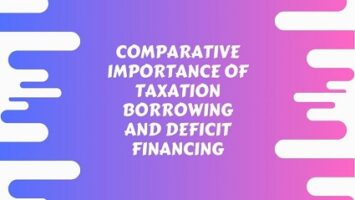Classical Views on the Burden of Public Debt:
Academic views regarding the burden of public debt have been changing according to the changes in general economic thinking. In the 18th century, public debt was favored by economists as they had great faith in the role of the State in economic activities and their favorable attitude towards public debt was a part of the Mercantilist doctrine. But in the 19th century and the early part of the 20th century, public debt was condemned by the early classical economists mainly because of their lack of faith in the role of the State in economic activities. Public spending was considered by them as a wasteful and unproductive expenditure. There was no State intervention in the individual’s economic activities, rendering private enterprise infallible. The free competition was the order of the day. An argument for a laissez-faire economy was that maximizing private profit would ipso-facto lead to the maximization of social welfare.
In this context, J. B. Say said that “There is this grand distinction between an individual borrower and borrowing government that in general, the later borrows capital for the purpose of barren consumption and expenditure.”
Obviously, in this socio-political climate, public fiance had very little to do. Huge revenues were considered unnecessary for the conduct of minimum Government functions- the policy of minimum spending implied a policy of minimum taxation. This, in brief, was the traditional belief of public finance associated popularly with Gladstone in England, and Jefferson in America.
David Hume opposed public debt and said that “Nations once they began to borrow, would be unable to desist until they reached the point of bankruptcy.”
Adam Smith thought that once the sovereign started to borrow, his political power was increased because he was no longer dependent on tax exactions from his subjects. Therefore, borrowing encouraged the sovereign to wage needless wars, on the other hand, if taxes were raised to meet current costs, “War would, in general, be more speedily concluded and less wantonly undertaken”. In short, the ability to engage in loan finance makes for irresponsibility in sovereign”.
Ricardo characterized national debt as, “….one of the most terrible scourges which was ever invented to afflict a nation”.
David Hume, Adam Smith, and David Ricardo had identical views about the consequence of public debt. Their opposition to public debt was on the ground that public expenditure is wasteful and unproductive.
However, subsequent thinkers like Malthus, Mill, Sidwick, and Cairness had some liberal views about the consequence of public debt. As Malthus said that “The material debt is not the evil which is generally supposed to be. Those who live on the interest from the national debt, like statesmen, soldiers, and sailors,….contribute powerfully to distribution and demand….they ensure that effective consumption which is necessary to give the proper stimulus to production……Therefore, the debt, once created, is not a great evil”.
The classical theory of public debt came to be formulated in the last decades of the 19th century. H. C. Adams and C. F. Bastable who may be taken to be the best representatives of the Classical theory of public debt refuted the idea that the burden of public debt cannot be shifted onto future generations. C .F. Bastable has clearly stated that by the creation of debt rather than by taxing, the burden is carried forward in time and that analogy between private debt and public debt is quite right, and that there is no significant difference between internal public debt and external public debt. Distinguishing between loan and tax he wrote, “A loan is voluntary, and supplied by willing givers, taxation is levied on the willing and unwilling alike. To make things smooth for the present at the cost of the future is not the duty of the wise and far-seeing statesmen”.
About the analogy between the public debt and private debt, C. F. Bastbale wrote that “in all essential points the analogy between the public and private debt does hold good and should never be lost sight of. The peculiar position of the state economy and the great importance of public borrowing have both tended to obscure the fundamental truth that public credit is but one form of credit in general and is, or ought to be, regulated by the same lending principle”.
Regarding the distinction between internal and external loans. C . F. Bastbale wrote that “From a purely financial point of view the source of loan is really immaterial. In any case, it is an immediate relief to the taxpayer counterbalanced by a greater charge on future”.
The burden thesis of the classical public debt theory was never firmly established. There were many dissents to the classical view.









Comments (No)